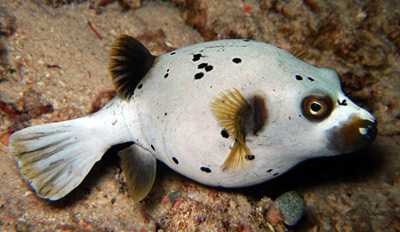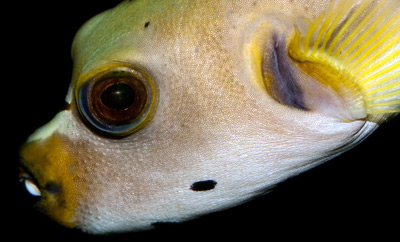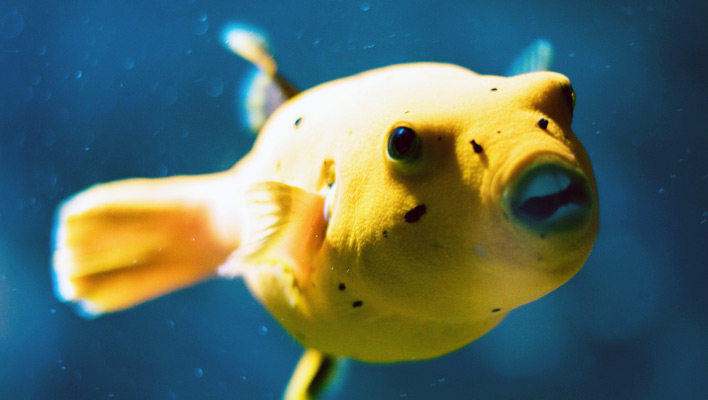Hobbyists with sizeable tanks who are looking for a truly pet-like fish won’t be disappointed in the aptly named dogface puffer (Arothron nigropunctatus). Looking rather like a pudgy beagle with fins instead of paws, A. nigropunctatus is loaded with piscine personality—though I wouldn’t recommend trying to scratch its chin or rub its belly.
Physical appearance
A. nigropuctatus reaches just over a foot in total length and is somewhat football shaped with a protruding, dog-like snout. Its coloration is quite variable from one individual to the next. Specimens may be various shades of brown, gray, white, or even yellow overall with sundry spots or larger blotches. In typical puffer fashion, its teeth are fused together into four plates that form a beak-like structure, which enables it to crunch stony corals, crustaceans, mollusks, and other invertebrate prey.
The power to puff
 In keeping with its common name, the dogface puffer is capable of inflating its body with water or air if it feels threatened. Inflating is very stressful to the puffer, so this response should never be intentionally elicited. Also, be aware that if a puffer inflates with air, it may not be able to expel it, which can prove deadly. As a precaution against this, puffers should never be netted and lifted out of the water when transferring them. Instead, gently herd the specimen into an appropriately sized rigid container and transfer it while fully submerged.
In keeping with its common name, the dogface puffer is capable of inflating its body with water or air if it feels threatened. Inflating is very stressful to the puffer, so this response should never be intentionally elicited. Also, be aware that if a puffer inflates with air, it may not be able to expel it, which can prove deadly. As a precaution against this, puffers should never be netted and lifted out of the water when transferring them. Instead, gently herd the specimen into an appropriately sized rigid container and transfer it while fully submerged.
A special note on puffer teeth
In common with most puffers, A. nigropunctatus’ teeth will continually grow if not worn down by hard-shelled food items. If these are not a regular feature in its diet, its teeth can grow to the point where it can no longer eat. In that event, the only remaining option is to resort to crude and stressful (to both puffer and hobbyist) dentistry—anesthetizing the fish and then filing down/clipping its teeth.
Feeding
 Your dogface puffer may need some coaxing to begin feeding initially (or may go on a hunger strike later if it’s unhappy with something in its environment), but most specimens will soon learn to accept a relatively wide variety of meaty marine foods—again, ensuring that some items of the crustacean or mollusk persuasion (shrimp, clams, mussels, crab legs, etc.) are left in their shells to help wear down those teeth. In addition to meaty foods, be sure to include some algae-based items, such as a frozen herbivore formulations. Small meals should be offered multiple times per day.
Your dogface puffer may need some coaxing to begin feeding initially (or may go on a hunger strike later if it’s unhappy with something in its environment), but most specimens will soon learn to accept a relatively wide variety of meaty marine foods—again, ensuring that some items of the crustacean or mollusk persuasion (shrimp, clams, mussels, crab legs, etc.) are left in their shells to help wear down those teeth. In addition to meaty foods, be sure to include some algae-based items, such as a frozen herbivore formulations. Small meals should be offered multiple times per day.
Housing
As I mentioned in my opening, dogface puffers need a good-sized aquarium to accommodate their impressive girth. I would recommend a tank in the vicinity of a standard 125-gallon for an adult specimen. Make sure the aquascaping provides both large open areas for swimming and a suitably sized cave/overhang for the puffer to refuge in. A more voluminous system will also act as a hedge against the water fouling that can easily occur with multiple daily feedings of meaty foods.
Tankmates
A. nigropunctatus is fairly nonaggressive as puffers go and will usually coexist with most fish species that aren’t either overly skittish or overly aggressive themselves, such as various wrasses, certain tangs, some triggers, larger angelfishes, etc. However, owing to this species’ natural diet of both sessile and motile invertebrates, it is a poor choice for reef systems and a threat to ornamental crustaceans.



